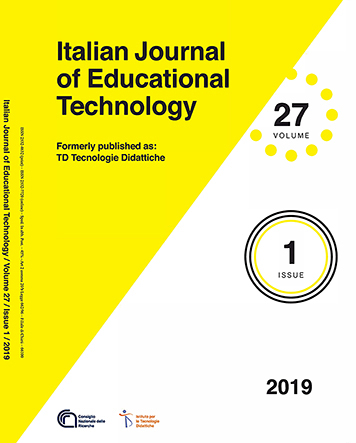REVISIONE SISTEMATICA SULL’UTILIZZO DI TECNOLOGIE DIGITALI PER LA VALUTAZIONE DEL MOVIMENTO IN EDUCAZIONE FISICA E IN SCIENZE MOTORIE E SPORTIVE
Contenuto principale dell'articolo
Abstract
Il lavoro presenta una revisione sistematica della letteratura sull’utilizzo di tecnologie digitali a supporto della valutazione del movimento nei contesti educativi. Complessivamente sono stati individuati, dopo opportuno processo di screening, 12 contributi scientifici in accordo con lo scopo di questa revisione. Dai risultati emerge che le tecnologie utilizzate si possono suddividere in tre categorie: video riprese, sensori indossabili ed exergames. Dall’analisi risulta come il loro utilizzo, pur essendo ancora limitato in estensione, sembri fornire validità, oggettività e affidabilità alla valutazione delle abilità motorie fondamentali e delle abilità sportive. Inoltre, il supporto tecnologico può permettere la stima dei relativi livelli di sviluppo, favorendo l’adozione di programmi di insegnamento adattati alle caratteristiche di ogni alunno e/o gruppo classe.
Dettagli dell'articolo
Gli autori che pubblicano su questa rivista accettano le seguenti condizioni:
- Gli autori mantengono i diritti sulla loro opera e cedono alla rivista il diritto di prima pubblicazione dell'opera, contemporaneamente licenziata sotto una Licenza Creative Commons CC BY 4.0 Attribution 4.0 International License.
- Gli autori possono aderire ad altri accordi di licenza non esclusiva per la distribuzione della versione dell'opera pubblicata (es. depositarla in un archivio istituzionale o pubblicarla in una monografia), a patto di indicare che la prima pubblicazione è avvenuta su questa rivista.
- Gli autori possono diffondere la loro opera online (es. in repository istituzionali o nel loro sito web) prima e durante il processo di submission, poiché può portare a scambi produttivi e aumentare le citazioni dell'opera pubblicata (Vedi The effect of Open Access).
Riferimenti bibliografici
Bartlett, H. L., Ting, L. H., & Bingham, J. T. (2014). Accuracy of force and center of pressure measures of the Wii Balance Board. Gait Posture, 39(1), 224-228. doi: 10.1016/j.gaitpost.2013.07.010
Blomqvist, M., Vänttinen, T., & Luhtanen, P. (2005). Assessment of secondary school students' decision-making and game-play ability in soccer. Physical Education and Sport Pedagogy, 10(2), 107-119. doi: 10.1080/17408980500104992
Bryant, E. S., Duncan, M. J., & Birch, S. L. (2014). Fundamental movement skills and weight status in British primary school children. European Journal of Sport Science, 14(7), 730-736. doi: 10.1080/17461391.2013.870232
Calvani, A. (2009). ICT in schools: what rationale? A conceptual frame for a technological policy. Educational Technology, 49, 33-37.
Clark, R. A., Bryant, A. L., Pua, Y., McCrory, P., Bennell, K., & Hunt, M. (2010). Validity and reliability of the Nintendo Wii Balance Board for assessment of standing balance. Gait Posture, 31(3), 307-310. doi: 10.1016/j.gaitpost.2009.11.012
Department of Education Western Australia (2013). Fundamental movement skills: the tools for learning, teaching and assessment. Perth, Australia.
Grimpampi, E., Masci, I., Pesce, C., & Vannozzi, G. (2016). Quantitative assessment of developmental levels in overarm throwing using wearable inertial sensing technology. Journal of Sports Sciences, 34(18), 1759-1765. doi: 10.1080/02640414.2015.1137341
Hardy, L. L., Reinten-Reynolds, T., Espinel, P., Zask, A., & Okely, A. D. (2012). Prevalence and correlates of low fundamental movement skill competency in children. Pediatrics, 130(2), e390-e398. doi: 10.1542/peds.2012-0345
Hopple, L. & Graham, G. (1995). What children think, feel and know about Physical 775 Fitness testing. Journal of Teaching in Physical Education, 14(4), 408-417. doi: 10.1123/jtpe.14.4.408
Hu, P. J. H., Clark, T. H., & Ma, W. W. (2003). Examining technology acceptance by school teachers: a longitudinal study. Information & Management, 41(2), 227-241. doi: 10.1016/S0378-7206(03)00050-8
Jonassen, D. H., Peck, K. L., & Wilson, B. G. (1999). Learning with technology: A constructivist perspective. Upper Saddle River, NJ: Prentice Hall.
Kennedy, G. E., Judd, T. S., Churchward, A., Gray, K., & Krause, K. L. (2008). First year students' experiences with technology: Are they really digital natives? Australasian Journal of Educational Technology, 24(1), 108-122. doi: 10.14742/ajet.1233
Kovalskys, I., Herscovici, C. R., Rougier, P. I., De Gregorio, M. J., Zonis, L., & Orellana, L. (2017). Study Protocol of MINI SALTEN: a technology-based multi-component intervention in the school environment targeting healthy habits of first grade children and their parents. BMC Public Health, 17(1), 401. doi: 10.1186/s12889-017-4327-3
Lahno, O., Hanjukova, O., & Cherniavska, O. (2015). Evaluation of the effectiveness of integrated psychomotor development of children in the age from 2 to 4. Journal of Physical Education and Sport, 15(4), 793. doi: 10.7752/jpes.2015.04121
Leach, J. M., Mancini, M., Peterka, R. J., Hayes, T. L., & Horak, F. B. (2014). Validating and calibrating the Nintendo Wii balance board to derive reliable center of pressure measures. Sensors, 14(10), 18244-18267. doi: 10.3390/s141018244
López-Pastor, V. M., Kirk, D., Lorente-Catalán, E., MacPhail, A., & Macdonald, D. (2013). Alternative assessment in physical education: a review of international literature. Sport, Education and Society, 18(1), 57-76. doi: 10.1080/13573322.2012.713860
Moher, D., Liberati, A., Tetzlaff, J., & Altman, D. G. (2009). Linee guida per il reporting di revisioni sistematiche e meta-analisi: il PRISMA Statement. PLoS Med, 6(7), e1000097, 1-8. Retrieved from http://www.prisma-statement.org/documents/PRISMA%20Italian%20Statement.pdf
National Association for Sport and Physical Education. (2009). Appropriate use of instructional technology in physical education. Reston, VA.
Okojie, M. C., Olinzock, A. A., & Okojie-Boulder, T. C. (2006). The pedagogy of technology integration. The Journal of Technology Studies, 32(2). doi: https://doi.org/10.21061/jots.v32i2.a.1
O’Loughlin, J., Chróinín, D. N., & O’Grady, D. (2013). Digital video: The impact on children’s learning experiences in primary physical education. European Physical Education Review, 19(2), 165-182. doi: 10.1177/1356336X13486050
Orofino, F., Sgro, F., Coppola, R., Crescimanno, C., & Lipoma, M. (2015). Examining the Influence of Different Physical Activity Training on the Postural Stability of University Students. International Journal of Human Movement and Sports Sciences, 3(3), 40-45. doi: 10.13189/saj.2015.030303
Penney, D., Jones, A., Newhouse, P., & Cambell, A. (2012). Developing a digital assessment in senior secondary physical education. Physical Education and Sport Pedagogy, 17(4), 383-410. doi: 10.1080/17408989.2011.582490
Rosenberg, M., Thornton, A. L., Lay, B. S., Ward, B., Nathan, D., Hunt, D., & Braham, R. (2016). Development of a kinect software tool to classify movements during active video gaming. PloS One, 11(7). doi: 10.1371/journal.pone.0159356
Sheehan, D. P., & Katz, L. (2012). The impact of a Six Week Exergaming Curriculum on Balance with Grade Three School Children using the Wii FIT+TM. International Journal of Computer Science in Sport, 11(3), 5-22.
Sgrò, F., Barresi, M., Pignato, S., & Lipoma, M. (2017). The use of exergames in physical education to improve the proficiency level of balance skills in children. Italian Journal of Educational Research, 19, 139-152. Retrieved from http://ojs.pensamultimedia.it/index.php/sird/article/view/2550
Sgrò, F., Mango, P., Pignato, S., Schembri, R., Licari, D., & Lipoma, M. (2017). Assessing Standing Long Jump Developmental Levels Using an Inertial Measurement Unit. Perceptual and Motor Skills, 124(1), 21-38. doi: 10.1177/0031512516682649
Sgrò, F., Nicolosi, S., Schembri, R., Pavone, M., & Lipoma, M. (2015). Assessing vertical jump developmental levels in childhood using a low-cost motion capture approach. Perceptual and Motor Skills, 120(2), 642-658. doi: 10.2466/10.PMS.120v12x7
Sgrò, F., Quinto, A., Messana, L., Pignato, S., & Lipoma, M. (2017). Assessment of gross motor developmental level in Italian primary school children. Journal of Physical Education and Sport, 17(3), 1954-1959. doi: 10.7752/jpes.2017.03192
Sgrò, F., Quinto, A., Pignato, S., & Lipoma, M. (2016). Comparison of product and process oriented model accuracy for assessing countermovement vertical jump motor proficiency in pre-adolescents. Journal of Physical Education and Sport, 16(3), 921. doi: 10.7752/jpes.2016.03145
Sgrò, F., Schembri, R., Nicolosi, S., Barresi, M., & Lipoma, M. (2013). Exergames for physical education: an overview about interaction design perspectives. World Journal on Educational Technology, 5(2), 248-256.
Sheehan, D. P., & Katz, L. (2012). The Impact of a Six Week Exergaming Curriculum on Balance with Grade Three School Children using the Wii FIT+™. International Journal of Computer Science in Sport, 11(3), 5-22.
Weir, T., & Connor, S. (2009). The use of digital video in physical education. Technology, Pedagogy and Education, 18(2), 155-171. doi: 10.1080/14759390902992642
Zhu, W., & Cole, E. L. (1996). Many-faceted Rasch calibration of a gross motor instrument. Research Quarterly for Exercise and Sport, 67(1), 24-34. doi: 10.1080/02701367.1996.10607922

